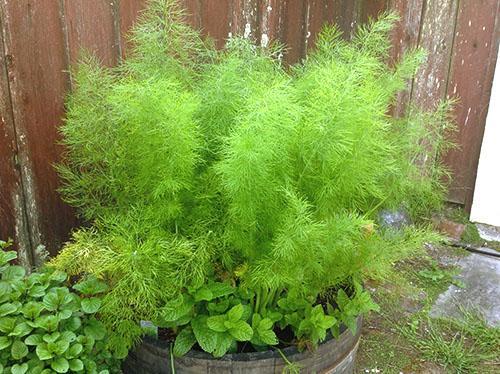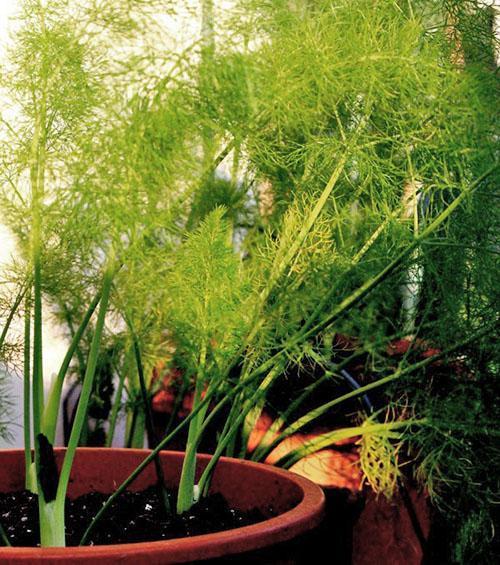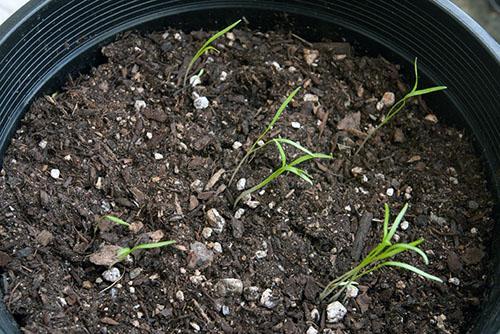Tips - how to grow dill at home
 Psychologists note that the sight of green houseplants helps to survive the winter time. If dill and other spicy herbs are grown on the windowsill, the benefits of such plantings will be many times greater, because the plants will not only remind you of summer, but also replenish the diet with vitamin greens.
Psychologists note that the sight of green houseplants helps to survive the winter time. If dill and other spicy herbs are grown on the windowsill, the benefits of such plantings will be many times greater, because the plants will not only remind you of summer, but also replenish the diet with vitamin greens.
Despite its unpretentiousness in the garden, in an apartment dill requires more attention, but in response to proper care, it will certainly delight you with fragrant foliage and a long growing season. How to grow dill at home? What are the features of sowing and caring for this crop, and what can interfere with obtaining a bountiful harvest greenery on the windowsill?
Choosing a variety of dill for the windowsill

Today there are several dozen worthy varieties that have proven themselves in the open field. For a pot culture, plants that give green mass as long and abundantly as possible are suitable.
An example of such varieties are:
- Asparagus bouquet.
- Superdukat.
- Beam.
- Abundant.
- Kibray.
Dill plants that form a dense green bush on the windowsill feel good.
If necessary, actively growing shoots can be pinched off to cause branching and the appearance of new foliage.
Growing dill from seeds at home
 Like other umbrella crops, dill is characterized by tight germination. This is due to the essential oils that protect the seed, but also slow down its pecking. How to grow dill at home and bring greenery closer?
Like other umbrella crops, dill is characterized by tight germination. This is due to the essential oils that protect the seed, but also slow down its pecking. How to grow dill at home and bring greenery closer?
If you do not take special measures, it will take at least two weeks to wait for the emergence of seedlings, even with regular watering, and to speed up the biological process, the seeds are soaked before sowing. To do this, use warm water or a solution of biostimulants, and in the latter case, after a daily stay in a solution of Kornevin or Ribav-Extra, the sprouts appear already on the 3-4th day, and the germination rate increases to 100%.
What containers are suitable for growing dill from seeds? A wide container or pot with drainage holes is prepared for sowing dill. The capacity is selected in such a way that several plants planted from intervals of 7-10 cm are not too crowded. The drainage layer, 1.5–2.5 cm thick, is made of fine expanded clay or stone chips.
 The soil for growing dill at home should be loose, retaining moisture well, not acidic and fertile. A ready-made soil mixture for vegetable crops or seedlings is quite suitable, or you can get soil by mixing garden soil in equal proportions, peat, sand and humus. Sowing is carried out in moist soil to a depth of about a centimeter. In order to initially avoid excessive seedling density, the seeds are sealed at intervals of 2-3 cm, sprinkling with a layer of peat on top and carefully compacting the soil.
The soil for growing dill at home should be loose, retaining moisture well, not acidic and fertile. A ready-made soil mixture for vegetable crops or seedlings is quite suitable, or you can get soil by mixing garden soil in equal proportions, peat, sand and humus. Sowing is carried out in moist soil to a depth of about a centimeter. In order to initially avoid excessive seedling density, the seeds are sealed at intervals of 2-3 cm, sprinkling with a layer of peat on top and carefully compacting the soil.
As shoots appear, they are additionally thinned out so that the plants do not interfere with each other and do not stretch out due to lack of space, nutrition and light.
Care features
 However, such a measure is clearly not enough.Even a south-facing room is less illuminated than a garden bed, and the air is sometimes drier and warmer than the ideal crop temperature range of 16-22 ° C. Therefore, it is more difficult to grow dill on a windowsill than in an open field.
However, such a measure is clearly not enough.Even a south-facing room is less illuminated than a garden bed, and the air is sometimes drier and warmer than the ideal crop temperature range of 16-22 ° C. Therefore, it is more difficult to grow dill on a windowsill than in an open field.
Although the culture is cold-resistant, and dill bushes grown at home will not lose the ability to grow even when the temperature drops to +8 ° C. But, once in a hot room, with a lack of watering, the plants refuse to form leaves and quickly release flower stalks. Dill reacts perfectly to moisture, but here it is important to remember: “the higher the temperature, the more often and more abundantly watering».
- If it is cool enough on the windowsill, excess moisture can cause root rot and plant death.
- In hot weather or when the heating is on, the absence of moisture is quickly recognized by sluggish discolored shoots.
- At temperatures above +25 ° C, dill on the windowsill should be regularly sprayed, this will help the plant to cope with increased dry air and heat.
Watering is carried out as the soil dries up, in small portions, preventing the formation of a dense crust on the soil.
 So that, as the bushes grow, they do not experience a deficiency of nutrients, they feed dill on the windowsill twice a month. To do this, you can use complex additives with a low nitrogen content, so that this element does not accumulate in the greens entering the table.
So that, as the bushes grow, they do not experience a deficiency of nutrients, they feed dill on the windowsill twice a month. To do this, you can use complex additives with a low nitrogen content, so that this element does not accumulate in the greens entering the table.
Lighting conditions for growing dill from seeds
 Green crops in the apartment are allocated the brightest places, while taking care that direct rays of the sun do not fall on the pots.
Green crops in the apartment are allocated the brightest places, while taking care that direct rays of the sun do not fall on the pots.
If the sowing of dill, even at home, takes place from March to August, plants create lush bushes on well-lit windowsills and do not require additional lighting.
But most often dill is grown at home in the winter. And here you can not do without artificial lighting of landings. It is best to hang a special phytolamp at a height of 50-60 cm from the home plantation, giving the spectrum necessary for the plants. If this is not possible, white light fluorescent lamps will do. With considering backlight daylight hours for dill on the windowsill should last up to 13-15 hours. Such a measure is especially important at the stage of emergence, until the plants have risen and matured.
By receiving the required amount of light, the bushes will not lean against the window pane, stretch out and look weakened.
How to grow dill on a windowsill so that the supply of greens to the table is uninterrupted? Unlike parsley, which for a long time releases new leaves instead of the collected ones, dill practically does not form greens after cutting. Therefore, 14–20 days after the first sowing, the next batch of seeds is sown. In this case, on the windowsill there will always be dill ready to harvest with marketable greens of approximately 10 centimeters in length.
Of all that I have come across before, this particular article "Tips - how to grow dill at home" dated September 27, 2015 turned out to be the most informative and useful for me. I don't know the author's name, but I thank him for the practical advice and nuances that he shared. Thanks to the site for publishing.